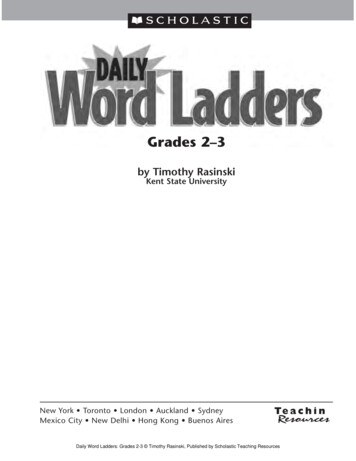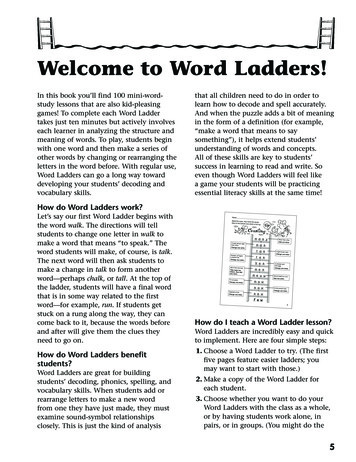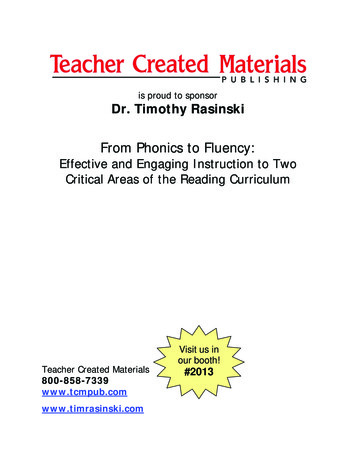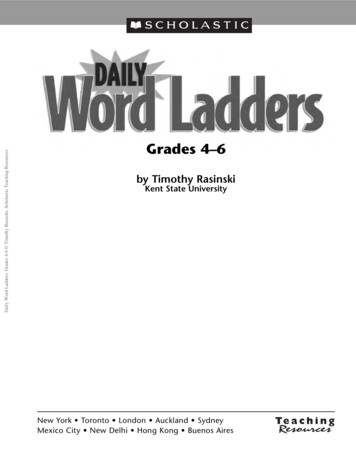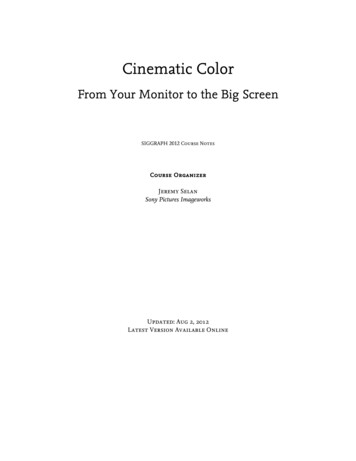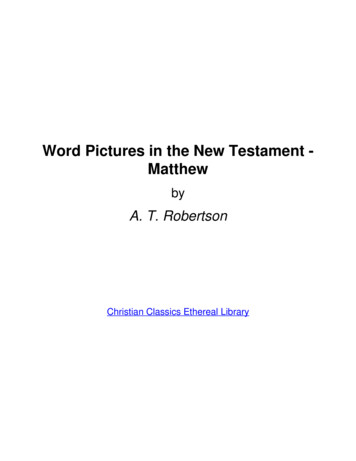
Transcription
Word Pictures in the New Testament MatthewbyA. T. RobertsonChristian Classics Ethereal Library
About Word Pictures in the New Testament - Matthew by A. T. RobertsonTitle:URL:Author(s):Publisher:Rights:Date Created:CCEL Subjects:LC Call no:LC Subjects:Word Pictures in the New Testament - Matthewhttp://www.ccel.org/ccel/robertson at/wp matt.htmlRobertson, A. T. (1863-1934)Grand Rapids, MI: Christian Classics Ethereal LibraryCopyright Christian Classics Ethereal Library2000-07-09All; Reference;BS2341 .R6The BibleNew TestamentWorks about the New Testament
Word Pictures in the New Testament - MatthewA. T. RobertsonTable of ContentsAbout This Book. . . . . . . . . . . .Title Page. . . . . . . . . . . . . . . .Introduction. . . . . . . . . . . . . . .Chapter 1. . . . . . . . . . . . . . . .Chapter 2. . . . . . . . . . . . . . . .Chapter 3. . . . . . . . . . . . . . . .Chapter 4. . . . . . . . . . . . . . . .Chapter 5. . . . . . . . . . . . . . . .Chapter 6. . . . . . . . . . . . . . . .Chapter 7. . . . . . . . . . . . . . . .Chapter 8. . . . . . . . . . . . . . . .Chapter 9. . . . . . . . . . . . . . . .Chapter 10. . . . . . . . . . . . . . . .Chapter 11. . . . . . . . . . . . . . . .Chapter 12. . . . . . . . . . . . . . . .Chapter 13. . . . . . . . . . . . . . . .Chapter 14. . . . . . . . . . . . . . . .Chapter 15. . . . . . . . . . . . . . . .Chapter 16. . . . . . . . . . . . . . . .Chapter 17. . . . . . . . . . . . . . . .Chapter 18. . . . . . . . . . . . . . . .Chapter 19. . . . . . . . . . . . . . . .Chapter 20. . . . . . . . . . . . . . . .Chapter 21. . . . . . . . . . . . . . . .Chapter 22. . . . . . . . . . . . . . . .Chapter 23. . . . . . . . . . . . . . . .Chapter 24. . . . . . . . . . . . . . . .Chapter 25. . . . . . . . . . . . . . . .Chapter 26. . . . . . . . . . . . . . . .Chapter 27. . . . . . . . . . . . . . . .Chapter 28. . . . . . . . . . . . . . . .Indexes. . . . . . . . . . . . . . . . . .Index of Scripture References. .Index of Scripture Commentary.Latin Words and Phrases. . . . .iii.p. iip. 1p. 2p. 5p. 11p. 16p. 20p. 25p. 32p. 38p. 41p. 46p. 50p. 56p. 61p. 65p. 73p. 78p. 82p. 88p. 92p. 97p. 101p. 105p. 110p. 114p. 119p. 125p. 129p. 141p. 152p. 157p. 157p. 162p. 162
Word Pictures in the New Testament - MatthewA. T. Robertsoniv
Word Pictures in the New Testament - MatthewA. T. RobertsonWord Pictures in the New TestamentMatthewA.T. Robertson
Word Pictures in the New Testament - MatthewA. T. RobertsonIntroductionTHE GOSPEL ACCORDING TO MATTHEW BY WAY OF INTRODUCTIONThe passing years do not make it any plainer who actually wrote our Greek Matthew. Papias records,as quoted by Eusebius, that Matthew wrote the Logia of Jesus in Hebrew (Aramaic). Is our presentMatthew a translation of the Aramaic Logia along with Mark and other sources as most modernscholars think? If so, was the writer the Apostle Matthew or some other disciple? There is at presentno way to reach a clear decision in the light of the known facts. There is no real reason why theApostle Matthew could not have written both the Aramaic Logia and our Greek Matthew, unlessone is unwilling to believe that he would make use of Mark’s work on a par with his own. ButMark’s book rests primarily on the preaching of Simon Peter. Scholfield has recently (1927)published An Old Hebrew Text of St. Matthew’s Gospel. We know quite too little of the origin ofthe Synoptic Gospels to say dogmatically that the Apostle Matthew was not in any real sense theauthor.If the book is genuine, as I believe, the date becomes a matter of interest. Here again there is nothingabsolutely decisive save that it is later than the Gospel according to Mark which it apparently uses.If Mark is given an early date, between A.D. 50 to 60, then Matthew’s book may be between 60and 70, though many would place it between 70 and 80. It is not certain whether Luke wrote afterMatthew or not, though that is quite possible. There is no definite use of Matthew by Luke that hasbeen shown. One guess is as good as another and each decides by his own predilections. My ownguess is that A.D. 60 is as good as any.In the Gospel itself we find Matthew the publican (Mt 9:9; 10:3) though Mark (Mr 2:14) and Luke(Lu 5:27) call him Levi the publican. Evidently therefore he had two names like John Mark. It issignificant that Jesus called this man from so disreputable a business to follow him. He wasapparently not a disciple of John the Baptist. He was specially chosen by Jesus to be one of theTwelve Apostles, a business man called into the ministry as was true of the fishermen James andJohn, Andrew and Simon. In the lists of the Apostles he comes either seventh or eighth. There isnothing definite told about him in the Gospels apart from the circle of the Twelve after the feastwhich he gave to his fellow publicans in honor of Jesus.Matthew was in the habit of keeping accounts and it is quite possible that he took notes of thesayings of Jesus as he heard them. At any rate he gives much attention to the teachings of Jesus as,for instance, the Sermon on the Mount in chapters Mt 5-7, the parables in Mt 13, the denunciationof the Pharisees in Mt 23, the great eschatological discourse in Mt 24; 25. As a publican in Galileehe was not a narrow Jew and so we do not expect a book prejudiced in favor of the Jews and againstthe Gentiles. He does seem to show that Jesus is the Messiah of Jewish expectation and hope and2
Word Pictures in the New Testament - MatthewA. T. Robertsonso makes frequent quotations from the Old Testament by way of confirmation and illustration.There is no narrow nationalism in Matthew. Jesus is both the Messiah of the Jews and the Saviourof the world.There are ten parables in Matthew not in the other Gospels: The Tares, the Hid Treasure, the Net,the Pearl of Great Price, the Unmerciful Servant, the Labourers in the Vineyard, the Two Sons, theMarriage of the King’s Son, the Ten Virgins, the Talents. The only miracles in Matthew alone arethe Two Blind Men, the Coin in the Mouth of the Fish. But Matthew gives the narrative of the Birthof Jesus from the standpoint of Joseph while Luke tells that wonderful story from the standpointof Mary. There are details of the Death and Resurrection given by Matthew alone.The book follows the same general chronological plan as that in Mark, but with various groups likethe miracles in Mt 8; 9, the parables in Mt 13.The style is free from Hebraisms and has few individual peculiarities. The author is fond of thephrase the kingdom of heaven and pictures Jesus as the Son of man, but also as the Son of God.He sometimes abbreviates Mark’s statements and sometimes expands them to be more precise.Plummer shows the broad general plan of both Mark and Matthew to be the same as follows:Introduction to the Gospel: Mr 1:1-13; Mt 3:1-4:11.Ministry in Galilee: Mr 1:14-6:13; Mt 4:12-13:58.Ministry in the Neighborhood: Mr 6:14-9:50; Mt 14:1-18:35.Journey through Perea to Jerusalem: Mr 10:1-52; Mt 19:1-20:34.Last week in Jerusalem: Mr 11:1-16:8; Mt 21:1-28:8.The Gospel of Matthew comes first in the New Testament, though it is not so in all the Greekmanuscripts. Because of its position it is the book most widely read in the New Testament and hasexerted the greatest influence on the world. The book deserves this influence though it is later indate than Mark, not so beautiful as Luke, nor so profound as John. Yet it is a wonderful book andgives a just and adequate portraiture of the life and teachings of Jesus Christ as Lord and Saviour.The author probably wrote primarily to persuade Jews that Jesus is the fulfilment of their Messianichopes as pictured in the Old Testament. It is thus a proper introduction to the New Testament storyin comparison with the Old Testament prophecy.THE TITLEThe Textus Receptus has “The Holy Gospel according to Matthew” [to kata Matthaion hagionEuaggelion], though the Elzevirs omit “holy,” not agreeing here with Stephanus, Griesbach, andScholz. Only minuscules (cursive Greek manuscripts) and all late have the adjective. Other3
Word Pictures in the New Testament - MatthewA. T. Robertsonminuscules and nine uncials including W (the Washington Codex of the fifth century), C of thefifth century (the palimpsest manuscript) and Delta of the ninth together with most Latin manuscriptshave simply “Gospel according to Matthew” [Euaggelion kata Matthaion]. But Aleph and B thetwo oldest and best Greek uncials of the fourth century have only “According to Matthew” [KataMaththaion] (note double th) and the Greek uncial D of the fifth or sixth century follows Alephand B as do some of the earliest Old Latin manuscripts and the Curetonian Syriac. It is clear,therefore, that the earliest form of the title was simply “According to Matthew.” It may be doubtedif Matthew (or the author, if not Matthew) had any title at all. The use of “according to” makes itplain that the meaning is not “the Gospel of Matthew,” but the Gospel as given by Matthew,[secundum Matthaeum], to distinguish the report by Matthew from that by Mark, by Luke, by John.Least of all is there any authority in the manuscripts for saying “Saint Matthew,” a Roman Catholicpractice observed by some Protestants.The word Gospel [Euaggelion] comes to mean good news in Greek, though originally a reward forgood tidings as in Homer’s Odyssey XIV. 152 and in 2Ki 4:10. In the New Testament it is the goodnews of salvation through Christ. The English word Gospel probably comes from the Anglo-SaxonGodspell, story or narrative of God, the life of Christ. It was early confused with the Anglo-Saxongodspell, good story, which seems like a translation of the Greek [euaggelion]. But primarily theEnglish word means the God story as seen in Christ which is the best news that the world has everhad. One thinks at once of the use of “word” [Logos] in Joh 1:1,14. So then it is, according to theGreek, not the Good News of Matthew, but the Good News of God, brought to us in Christ theWord, the Son of God, the Image of the Father, the Message of the Father. We are to study thisstory first as presented by Matthew. The message is God’s and it is as fresh to us today in Matthew’srecord as when he first wrote it.4
Word Pictures in the New Testament - MatthewA. T. RobertsonChapter 11:1 The Book [biblos]. There is no article in the Greek, but the following genitives make itdefinite. It is our word Bible that is here used, the Book as Sir Walter Scott called it as he lay dying.The usual word for book is a diminutive form [biblion], a little book or roll such as we have in Lu4:17, “The roll of the prophet Isaiah.” The pieces of papyrus [papuros], our paper, were pastedtogether to make a roll of varying lengths according to one’s needs. Matthew, of course, is notapplying the word book to the Old Testament, probably not to his own book, but to “the genealogicaltable of Jesus Christ” [biblos genese s I sou Christou], “the birth roll of Jesus Christ” Moffatttranslates it. We have no means of knowing where the writer obtained the data for this genealogy.It differs radically from that in Lu 3:23-38. One can only give his own theory of the difference.Apparently in Matthew we have the actual genealogy of Joseph which would be the legal pedigreeof Jesus according to Jewish custom. In Luke we apparently have the actual genealogy of Marywhich would be the real line of Jesus which Luke naturally gives as he is writing for the Gentiles.Jesus Christ. Both words are used. The first is the name [I sous] given by the angel to Mary (Mt1:21) which describes the mission of the child. The second was originally a verbal adjective [christos]meaning anointed from the verb to anoint [chri ]. It was used often in the Septuagint as an adjectivelike “the anointed priest” (1Ki 2:10) and then as a substantive to translate the Hebrew word“Messiah” [Messias]. So Andrew said to Simon: “We have found the Messiah, which is, beinginterpreted, Christ” (Joh 1:41). In the Gospels it is sometimes “the Anointed One,” “the Messiah,”but finally just a proper name as here, Jesus Christ. Paul in his later Epistles usually has it “ChristJesus.”The Son of David, the son of Abraham [huiou Daueid huiou Abraam]. Matthew proposes to showthat Jesus Christ is on the human side the son of David, as the Messiah was to be, and the son ofAbraham, not merely a real Jew and the heir of the promises, but the promise made to Abraham.So Matthew begins his line with Abraham while Luke traces his line back to Adam. The Hebrewand Aramaic often used the word son [b n] for the quality or character, but here the idea is descent.Christians are called sons of God because Christ has bestowed this dignity upon us (Ro 8:14; 9:26;Ga 3:26; 4:5-7). Verse 1 is the description of the list in verses 2-17. The names are given in threegroups, Abraham to David (2-6), David to Babylon Removal (6-11), Jechoniah to Jesus (12-16).The removal to Babylon [metoikesias Babul nos] occurs at the end of verse 11, the beginning ofverse 12, and twice in the resume in verse 17. This great event is used to mark off the two lastdivisions from each other. It is a good illustration of the genitive as the case of genus or kind. TheBabylon removal could mean either to Babylon or from Babylon or, indeed, the removal of Babylon.But the readers would know the facts from the Old Testament, the removal of the Jews to Babylon.Then verse 17 makes a summary of the three lists, fourteen in each by counting David twice andomitting several, a sort of mnemonic device that is common enough. Matthew does not mean to5
Word Pictures in the New Testament - MatthewA. T. Robertsonsay that there were only fourteen in actual genealogy. The names of the women (Thamar, Rahab,Ruth, Bathsheba the wife of Uriah) are likewise not counted. But it is a most interesting list.1:2 Begat [egenn sen]. This word comes, like some of the early chapters of Genesis, with regularitythrough verse 16, until the birth of Jesus is reached when there is a sudden change. The word itselfdoes not always mean immediate parentage, but merely direct descent. In verse 16 we have “Josephthe husband of Mary, from whom was begotten Jesus who is called Christ” [ton I s ph ton andraMarias ex h s egenn th I sous ho legomenos Christos]. The article occurs here each time with theobject of “begat,” but not with the subject of the verb to distinguish sharply the proper names. Inthe case of David the King (1:6) and Joseph the husband of Mary (1:16) the article is repeated. Themention of the brethren of Judah (1:2) and of both Phares and Zara (1:3) may show that Matthewwas not copying a family pedigree but making his own table. All the Greek manuscripts give verse16 as above save the Ferrar Group of minuscules which are supported by the Sinaitic Syriac Version.Because of this fact Von Soden, whose text Moffatt translates, deliberately prints his text ”Jacobbegat Jesus” [I s ph de egenn sen I soun]. But the Sinaitic Syriac gives the Virgin Birth of Jesus inMt 1:18-25. Hence it is clear that “begat” here in 1:16 must merely mean line of descent or the texthas been tampered with in order to get rid of the Virgin Birth idea, but it was left untouched in1:18-25. I have a full discussion of the problem in chapter XIV of Studies in the Text of the NewTestament. The evidence as it now stands does not justify changing the text of the Greek uncialsto suit the Sinaitic Syriac. The Virgin Birth of Jesus remains in 1:16. The spelling of these Hebrewnames in English is usually according to the Hebrew form, not the Greek. In the Greek itself theHebrew spelling is often observed in violation of the Greek rules for the ending of words with noconsonants save n, r, s. But the list is not spelled consistently in the Greek, now like the Hebrewas in Abraham, Isaac, Jacob, now like the Greek as in Judah, Solomon, Hezekiah, though the Hebrewstyle prevails.1:18 The birth of Jesus Christ [tou [I sou] Christou h genesis]. In the Greek Jesus Christ comesbefore birth as the important matter after 1:16. It is not certain whether “Jesus” is here a part of thetext as it is absent in the old Syriac and the Old Latin while the Washington Codex has only “Christ.”The Vatican Codex has “Christ Jesus.” But it is plain that the story of the birth of Jesus Christ isto be told briefly as follows, “on this wise” [hout s], the usual Greek idiom. The oldest and bestmanuscripts have the same word genealogy [genesis] used in 1:1, not the word for birth (begotten)as in 1:16 [genn sis]. “It is in fact the word Genesis. The evangelist is about to describe, not thegenesis of the heaven and the earth, but the genesis of Him who made the heaven and the earth,and who will yet make a new heaven and a new earth” (Morison).Betrothed to Joseph [Mn steutheis s t i I s ph]. Matthew proceeds to explain his statement in 1:16which implied that Joseph, though the legal father of Jesus in the royal line, was not the actualfather of Mary’s Son. Betrothal with the Jews was a serious matter, not lightly entered into and notlightly broken. The man who betrothed a maiden was legally husband (Ge 29:21; De 22:23f.) and6
Word Pictures in the New Testament - MatthewA. T. Robertson“an informal cancelling of betrothal was impossible” (McNeile). Though they did not live togetheras husband and wife till actual marriage, breach of faithfulness on the part of the betrothed wastreated as adultery and punished with death. The New Testament in Braid Scots actually has “mairry’ttill Joseph” for “betrothed to Joseph.” Matthew uses the genitive absolute construction here, a verycommon Greek idiom.Of the Holy Ghost [ek pneumatos hagiou]. The discovery that Mary was pregnant was inevitableand it is plain that she had not told Joseph. She “was found with child” [heureth en gastri echousa].This way of putting it, the usual Greek idiom, plainly shows that it was the discovery that shockedJoseph. He did not as yet know what Matthew plainly asserts that the Holy Ghost, not Joseph andnot any man, was responsible for the pregnancy of Mary. The problem of the Virgin Birth of Jesushas been a disturbing fact to some through all the ages and is today to those who do not believe inthe pre-existence of Christ, the Son of God, before his Incarnation on earth. This is the primal factabout the Birth of Christ. The Incarnation of Christ is clearly stated by Paul (2Co 8:9; Php 2:5-11;and involved in Col 1:15-19) and by John (Joh 1:14; 17:5). If one frankly admits the actualpre-existence of Christ and the real Incarnation, he has taken the longest and most difficult step inthe matter of the supernatural Birth of Christ. That being true, no merely human birth without thesupernatural element can possibly explain the facts. Incarnation is far more than the Indwelling ofGod by the Holy Spirit in the human heart. To admit real incarnation and also full human birth,both father and mother, creates a greater difficulty than to admit the Virgin Birth of Jesus begottenby the Holy Spirit, as Matthew here says, and born of the Virgin Mary. It is true that only Matthewand Luke tell the story of the supernatural birth of Jesus, though Joh 1:14 seems to refer to it. Markhas nothing whatever concerning the birth and childhood of Jesus and so cannot be used as a witnesson the subject. Both Matthew and Luke present the birth of Jesus as not according to ordinaryhuman birth. Jesus had no human father. There is such a thing in nature as parthenogenesis in thelower orders of life. But that scientific fact has no bearing here. We see here God sending his Soninto the world to be the world’s Saviour and he gave him a human mother, but not a human fatherso that Jesus Christ is both Son of God and Son of Man, the God Man. Matthew tells the story ofthe birth of Jesus from the standpoint of Joseph as Luke gives it from the standpoint of Mary. Thetwo narratives harmonize with each other. One credits these most wonderful of all birth narrativesaccording as he believes in the love and power of Almighty God to do what he wills. There is nomiracle with God who has all power and all knowledge. The laws of nature are simply the expressionof God’s will, but he has not revealed all his will in the laws that we discover. God is Spirit. He isPerson. He holds in his own power all life. Joh 3:16 is called the Little Gospel because it puts brieflythe love of God for men in sending his own Son to live and die for us.1:19 A Righteous Man [dikaios]. Or just, not benignant or merciful. The same adjective is usedof Zacharias and Elizabeth (Lu 1:6) and Simeon (Lu 2:25). “An upright man,” the Braid Scots hasit. He had the Jewish conscientiousness for the observance of the law which would have been deathby stoning (De 22:23). Though Joseph was upright, he would not do that. “As a good Jew he would7
Word Pictures in the New Testament - MatthewA. T. Robertsonhave shown his zeal if he had branded her with public disgrace” (McNeile). And yet not willing[kai m thel n]. So we must understand [kai] here, “and yet.” Matthew makes a distinction herebetween “willing” [thel n] and “wishing” [eboul th ], that between purpose [thel ] and desire[boulomai] a distinction not always drawn, though present here. It was not his purpose to “makeher a public example” [deigmatisai], from the root [deiknumi] to show), a rare word (Col 2:15).The Latin Vulgate has it traducere, the Old Latin divulgare, Wycliff pupplische (publish), Tyndaledefame, Moffatt disgrace, Braid Scots “Be i the mooth o’ the public.” The substantive [deigmatismos]occurs on the Rosetta Stone in the sense of “verification.” There are a few instances of the verb inthe papyri though the meaning is not clear (Moulton and Milligan’s Vocabulary). The compoundform appears [paradeigmatiz ] in Heb 6:6 and there are earlier instances of this compound than ofthe uncompounded, curiously enough. But new examples of the simple verb, like the substantive,may yet be found. The papyri examples mean to furnish a sample (P Tebt. 5.75), to make trial of(P Ryl. I. 28.32). The substantive means exposure in (P Ryl. I. 28.70). At any rate it is clear thatJoseph “was minded to put her away privily.” He could give her a bill of divorcement [apolusai],the [g t] laid down in the Mishna, without a public trial. He had to give her the writ [g t] and paythe fine (De 24:1). So he proposed to do this privately [lathrai] to avoid all the scandal possible.One is obliged to respect and sympathize with the motives of Joseph for he evidently loved Maryand was appalled to find her untrue to him as he supposed. It is impossible to think of Joseph asthe actual father of Jesus according to the narrative of Matthew without saying that Matthew hastried by legend to cover up the illegitimate birth of Jesus. The Talmud openly charges this sinagainst Mary. Joseph had “a short but tragic struggle between his legal conscience and his love”(McNeile).1:20 An angel of the Lord appeared unto him in a dream [aggelos kuriou kat’ onar ephanaut i]. This expression [aggelos kuriou] is without the article in the New Testament except when,as in 1:24, there is reference to the angel previously mentioned. Sometimes in the Old TestamentJehovah Himself is represented by this phrase. Surely Joseph needed God’s help if ever man did.If Jesus was really God’s Son, Joseph was entitled to know this supreme fact that he might be justto both Mary and her Child. It was in a dream, but the message was distinct and decisive for Joseph.He is called “Son of David” as had been shown by Matthew in Mt 1:16. Mary is called his “wife”[t n gunaika sou]. He is told “not to become afraid” (ingressive first aorist passive subjunctive inprohibition), [m phob th is], “to take to his side” [paralabein], ingressive aorist active infinitive)her whom he had planned [enthum thentos], genitive absolute again, from [en] and [thumos] tosend away with a writ of divorce. He had pondered and had planned as best he knew, but now Godhad called a halt and he had to decide whether he was willing to shelter Mary by marrying her and,if necessary, take upon himself whatever stigma might attach to her. Joseph was told that the childwas begotten of the Holy Spirit and thus that Mary was innocent of any sin. But who would believeit now if he told it of her? Mary knew the truth and had not told him because she could not expecthim to believe it.8
Word Pictures in the New Testament - MatthewA. T. Robertson1:21 Thou shalt call his name Jesus [Kalesies to onoma autou I soun]. The rabbis named sixwhose names were given before birth: “Isaac, Ishmael, Moses, Solomon, Josiah, and the name ofthe Messiah, whom may the Holy One, blessed be His name, bring in our day.” The angel puts itup to Joseph as the putative father to name the child. “Jesus is the same as Joshua, a contraction ofJehoshuah (Nu 13:16; 1Ch 7:27), signifying in Hebrew, ‘Jehovah is helper,’ or ‘Help of Jehovah’”(Broadus). So Jesus is the Greek form of Joshua (Heb 4:8). He is another Joshua to lead the truepeople of God into the Promised Land. The name itself was common enough as Josephus shows.Jehovah is Salvation as seen in Joshua for the Hebrews and in Jesus for all believers. “The meaningof the name, therefore, finds expression in the title Saviour applied to our Lord (Lu 1:47; 2:11; Joh4:42)” (Vincent). He will save [s sei] his people from their sins and so be their Saviour [S t r]. Hewill be prophet, priest, and king, but “Saviour” sums it all up in one word. The explanation is carriedout in the promise, “for he is the one who [autos] will save [s sei] with a play on the name Jesus)his people from their sins.” Paul will later explain that by the covenant people, the children ofpromise, God means the spiritual Israel, all who believe whether Jews or Gentiles. This wonderfulword touches the very heart of the mission and message of the Messiah. Jesus himself will showthat the kingdom of heaven includes all those and only those who have the reign of God in theirhearts and lives. From their sins [apo t n hamarti n aut n]. Both sins of omission and of commission.The substantive [hamartia] is from the verb [hamartanein] and means missing the mark as with anarrow. How often the best of us fall short and fail to score. Jesus will save us away from [apo] aswell as out of [ex] our sins. They will be cast into oblivion and he will cover them up out of sight.1:22 That it may be fulfilled [hina pl r th i]. Alford says that “it is impossible to interpret [hina]in any other sense than in order that.” That was the old notion, but modern grammarians recognizethe non-final use of this particle in the Koin and even the consecutive like the Latin ut. Some evenargue for a causal use. If the context called for result, one need not hesitate to say so as in Mr 11:28;Joh 9:36; 1Jo 1:9; Re 9:20; 13:13. See discussion in my Grammar of the Greek New Testament inthe Light of Historical Research, pp. 997–9. All the same it is purpose here, God’s purpose, Matthewreports the angel as saying, spoken “by [hupo], immediate agent) the Lord through [dia], intermediateagent) the prophet.” “All this has happened” [touto de holon gegonen], present perfect indicative),stands on record as historical fact. But the Virgin Birth of Jesus is not due to this interpretation ofIsa 7:14. It is not necessary to maintain (Broadus) that Isaiah himself saw anything more in hisprophecy than that a woman then a virgin, would bear a son and that in the course of a few yearsAhaz would be delivered from the king of Syria and Israel by the coming of the Assyrians. Thishistorical illustration finds its richest fulfilment in the birth of Jesus from Mary. “Words ofthemselves are empty. They are useful only as vessels to convey things from mind to mind”(Morison). The Hebrew word for young woman is translated by virgin [parthenos], but it is notnecessary to conclude that Isaiah himself contemplated the supernatural birth of Jesus. We do nothave to say that the idea of the Virgin Birth of Jesus came from Jewish sources. Certainly it didnot come from the pagan myths so foreign to this environment, atmosphere and spirit. It is far9
Word Pictures in the New Testament - MatthewA. T. Robertsonsimpler to admit the supernatural fact than try to explain the invention of the idea as a myth tojustify the deification of Jesus. The birth, life, and death of Jesus throw a flood of light on the OldTestament narrative and prophecies for the early Christians. In Matthew and John in particular weoften see “that the events of Christ’s life were divinely ordered for the express purpose of fulfillingthe Old Testament” (McNeile). See Mt 2:15, 23; 4:14-17; 8:17; 12:17-21; 13:25; 21:4f.; Joh 12:38f.;13:18; 19:24, 28, 36f.1:23 They shall call [kalesousin]. Men, people, will call his name Immanuel, God with us. “Theinterest of the evangelist, as of all New Testament writers, in prophecy, was purely religious”(Bruce). But surely the language of Isaiah has had marvellous illustration in the Incarnation ofChrist. This is Matthew’s explanation of the meaning of Immanuel, a descriptive appellation ofJesus Christ a
Word Pictures in the New Testament - Matthew by A. T. Robertson Christian Classics Ethereal Library. This document has been generated from XSL (Extensible Stylesheet Language) source w

